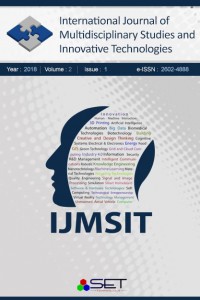Abstract
In universities, course attendance followed by
circulated sign paper in class. It is quite challenging and time consuming
process that following student’s participation for instructor. The number and
sign of each student is taken. But this process reduces the efficiency of the course
and causes time loss. In this study, for smart mobile devices Radio Frequency
Identification (RFID) and Bluetooth Low Energy (also known as Bluetooth LE)
technology developed student inspection application for smart mobile devices.
In developed application a circuit is designed and written a code for mobile
device using RFID reader and Bluetooth LE module. Student numbers predefined to
RFID-enabled ID card. Contactless RFID student information transmitted to
mobile device as wireless with Bluetooth and saved to database. End of the
period, hiden inspection informations in mobile device transmitted to server
computer and student-based statistical information may be taken.
Keywords
References
- [1] M. Mattam, S.R.M. Karumuri, and S.R.Meda, “Architecture for Automated Student Attendance,” in Proc. IEEE Fourth International Conference on Technology for Education (T4E 2012), pp.164-167, 18-20 July 2012
- [2] C.B.Chew, M.M-Singh, K.C.Wei, T.W.Sheng, M.H.Husin, N.H.A.H.Malim, “Sensors-enabled Smart Attendance Systems Using NFC and RFID Technologies”, International Journal of New Computer Architectures and their Applications (IJNCAA) 5(1): 19-28, 2015
- [3] V.D Hunt, A.Puglia and M.Puglia, A Guide to Radio Frequency Identification, New Jersey, John Wiley & Sons, Inc., Hoboken, 2007.
- [4] H.Lehpamer, RFID Design Principles, 2nd ed., Norwood:Artech House, 2012.
- [5] S.Ahson, M.Ilyas, RFID HandBook: Applications, Technology, Security, and Privacy, CRC Press is an imprint of Taylor & Francis Group, an Informa business, United States of America, 2008.
- [6] K. Finkenzeller, Fundamentals and Applications in Contactless Smart Cards, Radio Frequency Identification and Near-Field Communication, 3rd ed, United Kingdom, Wiley, 2010.
- [7] D. Schmidt, RFID im Mobile Supply Chain Event Management Anwendungsszenarien, Verbreitung und Wirtschaftlichkeit, Gabler Verlag, Wiesbaden, 2006.
- [8] N.Gupta, Inside Bluetooth Low Energy, United States of America, Artech House, 2013.
- [9] R.Heydon, Bluetooth Low Energy The Developer’s Handbook, United States of America, Pearson Education, Inc, 2013.
- [10] M.U.Aftab, Building Bluetooth Low Energy Systems, Birmingham, Packt Publishing, 2017.
Abstract
Üniversitelerde derse katılım takibi, yoklama
kâğıdı sınıfta dolaştırılarak yapılır. Öğrencilerin derse katılımını takip
etmek öğretim elemanı açısından oldukça uğraştırıcı ve zaman alıcı bir süreçtir.
Her bir öğrencinin numarası ve imzası alınır. Ancak, bu işlem dersin
verimliliğini azaltır ve zaman kaybına neden olur. Bu çalışmada, akıllı mobil
cihazlar için Radyo Frekanslı Tanımlama (RFID - Radio Frequency Identification)
ve Bluetooth düşük enerji ( Bluetooth Low Energy-Bluetooth LE olarak da
bilinir) teknolojisi kullanılarak öğrenci yoklama uygulaması geliştirilmiştir.
Geliştirilen uygulamada, RFID okuyucu ve Bluetooth LE modülü kullanılarak bir
devre tasarlanmış ve mobil cihaz için bir program yazılmıştır. Öğrencilerin
numaraları RFID özellikli kimlik kartlarına önceden tanımlanmıştır. RFID ile
temassız olarak okutulan öğrenci bilgisi Bluetooth ile kablosuz olarak mobil
cihaza iletilmiş ve veri tabanına kaydedilmiştir. Böylece ilgili ders için
öğrenci yoklaması alınmıştır. Dönem sonunda mobil cihazda saklanan yoklama
bilgileri, sunucu bilgisayara aktarılmış ve öğrenci bazında istatistiksel
bilgiler alınabilmiştir.
Keywords
References
- [1] M. Mattam, S.R.M. Karumuri, and S.R.Meda, “Architecture for Automated Student Attendance,” in Proc. IEEE Fourth International Conference on Technology for Education (T4E 2012), pp.164-167, 18-20 July 2012
- [2] C.B.Chew, M.M-Singh, K.C.Wei, T.W.Sheng, M.H.Husin, N.H.A.H.Malim, “Sensors-enabled Smart Attendance Systems Using NFC and RFID Technologies”, International Journal of New Computer Architectures and their Applications (IJNCAA) 5(1): 19-28, 2015
- [3] V.D Hunt, A.Puglia and M.Puglia, A Guide to Radio Frequency Identification, New Jersey, John Wiley & Sons, Inc., Hoboken, 2007.
- [4] H.Lehpamer, RFID Design Principles, 2nd ed., Norwood:Artech House, 2012.
- [5] S.Ahson, M.Ilyas, RFID HandBook: Applications, Technology, Security, and Privacy, CRC Press is an imprint of Taylor & Francis Group, an Informa business, United States of America, 2008.
- [6] K. Finkenzeller, Fundamentals and Applications in Contactless Smart Cards, Radio Frequency Identification and Near-Field Communication, 3rd ed, United Kingdom, Wiley, 2010.
- [7] D. Schmidt, RFID im Mobile Supply Chain Event Management Anwendungsszenarien, Verbreitung und Wirtschaftlichkeit, Gabler Verlag, Wiesbaden, 2006.
- [8] N.Gupta, Inside Bluetooth Low Energy, United States of America, Artech House, 2013.
- [9] R.Heydon, Bluetooth Low Energy The Developer’s Handbook, United States of America, Pearson Education, Inc, 2013.
- [10] M.U.Aftab, Building Bluetooth Low Energy Systems, Birmingham, Packt Publishing, 2017.
Details
| Primary Language | Turkish |
|---|---|
| Journal Section | Articles |
| Authors | |
| Publication Date | June 27, 2018 |
| Submission Date | May 18, 2018 |
| Published in Issue | Year 2018 Volume: 2 Issue: 1 |


